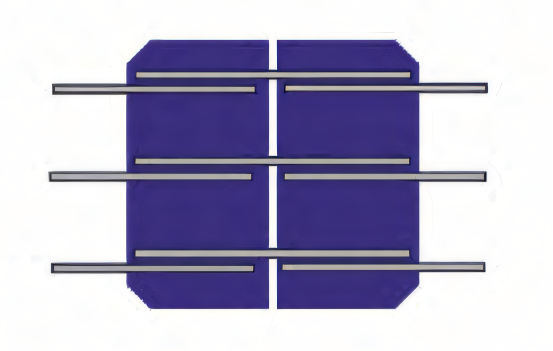
量子效率测试仪
PL/EL一体机
Sinton硅片少子寿命测试仪
Sinton硅块少子寿命测试仪
绒面反射率测试仪
3D共聚焦显微镜
清洗制绒工作站
在线四探针方阻测试仪
全自动扫描四探针方阻测试仪
在线薄膜厚度测试仪
晶化率测试仪
Horiba显微共焦拉曼光谱仪
傅里叶红外光谱仪
霍尔效应测试仪
分光光度计
全光谱椭偏仪
Horiba椭圆偏振光谱仪
TLM接触电阻率测试仪
超景深显微镜
网版智能影像测量仪
全自动影像测量仪
卧式拉力机
电池片稳态光衰老化试验箱
电池片紫外老化试验箱
电池片拉脱力综合测试仪
外观检验台
湿漏电测试系统
组件实验室EL测试仪
紫外老化试验箱
稳态光衰老化试验箱
电流连续性监测系统
PID测试系统
旁路二极管测试系统
LeTID测试系统
反向电流过载系统
脉冲电压测试系统
绝缘耐压测试仪
接地连续性测试仪
绝缘耐压接地测试仪
湿热环境试验箱
湿冻环境试验箱
热循环试验箱
动态机械载荷测试机
静态机械载荷测试机
冰雹冲击试验机
引出端强度试验机
霰弹冲击试验机
抗划伤(切割)测试机
剥离试验机
万能材料试验机(单臂)
万能材料试验机(双臂)
光伏玻璃透过率测试仪
醋酸测试试验箱
交联度测试系统
二极管接线盒综合测试仪
落球冲击试验机
半自动四探针
全自动探针式台阶仪
多通道太阳能MPPT系统
Horiba稳瞬态荧光光谱仪
钙钛矿P1激光划线测试仪
钙钛矿在线膜厚测试仪
钙钛矿工艺检测工作站
手持式IV测试仪
便携式EL测试仪
手持热成像测试仪
户外组件IV测试仪
户外组件多通道测试系统
光伏逆变器电能质量测试仪
无人机EL检测仪
0BB无主栅技术在IBC电池中的应用及封装测试
日期:2024-10-24浏览量:30
传统晶体硅太阳电池的正面金属电极会造成光学损失,减少正面金属电极覆盖面积可以提高效率。背接触太阳电池(IBC)将电极置于背面,提高光电转换效率。降低太阳电池组件成本是行业发展的重要方向,其中银浆成本占非硅成本的比例较高。0BB无主栅技术通过减少银浆使用量来降低成本,同时提升组件性能。
0BB无主栅技术
无主栅技术的优势在于降低银浆成本,减少遮光损失,缩短电流传输路径,降低串联电阻,提升组件功率。其发展历程包括从3BB-5BB到多主栅(MBB)和超级多主栅(SMBB)技术,无主栅技术采用铜焊丝取代传统主栅线,实现电流汇集和电池互联。

IBC电池无主栅互联示意图
无主栅技术通过减少或消除正面主栅,增加受光面积,减少电阻损耗,提高光电转换效率。无主栅太阳电池使用焊带作为正面主栅,连接到背面副栅。
无主栅IBC光伏组件的封装工艺

IBC光伏组件封装结构
常规工艺:采用双层复合膜(POE+PET)与铜丝复合形成导电带,经太阳电池焊接、组装、层压、削边装框等流程封装 IBC 光伏组件,但存在太阳电池弯曲、焊接不良、接触不良、界面分层开裂等问题。
工艺改进:采用单层复合膜(聚烯烃或乙烯 - 醋酸乙烯共聚物)替换双层复合膜,并引入一体膜,避免了太阳电池弯曲和焊接不良问题,且在TC 老化试验中不会产生分层现象。
IBC 光伏组件稳定性TC测试

热循环试验
测试对象:常规工艺和改进工艺的无主栅 IBC 光伏组件
测试条件:
在 1h 内将温度由 25°C 均速降低至 -40°C。然后保温 15min。
再在 3h 内由 -40°C 均速升温至 85°C。然后保温 15min。
最后在 2h 内由 85°C 均速降温至 25°C。试验共进行 400 次。
TC老化试验后,对两种工艺无主栅IBC光伏组件进行EL测试

常规工艺下的EL图像
随着TC老化试验的进行,达到200次后,常规工艺的无主栅IBC光伏组件的EL图像出现了明显的边缘发黑现象。这可能是由于双层复合膜中的PET膜在层压过程中无法熔化,导致产生了两个界面,在热循环老化过程中,弹性形变首先从边缘开始,且变形量不一致,使铜丝与太阳电池的副栅之间出现接触不良。

改进工艺下的EL图像
采用单层复合膜工艺避免了热压引起的IBC太阳电池的弯曲现象和焊接不良问题。单层复合膜在层压过程中熔化后与背面封装胶膜发生交联反应,形成稳固的封装体,在TC中不会产生分层现象。
在TC老化试验后,改进工艺的无主栅IBC光伏组件的EL图像仍保持良好的效果,没有出现明显的发黑或其他不良现象。
改进工艺通过优化工艺流程,显著提高了无主栅IBC光伏组件的可靠性和性能,减少了TC老化试验后的不良现象。改进工艺的无主栅IBC光伏组件在热循环老化试验后表现出更好的EL图像效果,具有更高的光电转换效率和更长的使用寿命。

联系电话:400 008 6690
美能热循环环境试验箱,可以验证评估太阳能电池/组件的可靠性和稳定性,并通过热疲劳诱导失效模式,早期识别制造缺陷。
满足标准:IEC61215-MQT11(热循环试验);IEC61730-MST51(温度循环试验)
升降温速率:-40℃~+85℃,线性0~3.3℃/min可调
平均耗电量:≤100 KW·h(TC200单个循环耗电量)
温度范围:-50℃ ~ +150℃
通过热循环测试的对比分析,证实了改进工艺在提高无主栅IBC光伏组件的可靠性和性能方面的优势,为光伏组件的封装技术发展提供了有益的指导。美能热循环环境试验箱可以模拟快速的温度变化,研究人员能够更准确地评估无主栅IBC光伏组件在经过改进工艺后的性能提升和可靠性改进。
原文出处:DOI:10.19911/j.1003-0417.tyn20230628.01,应用于IBC光伏组件的无主栅技术及封装材料研究




































































